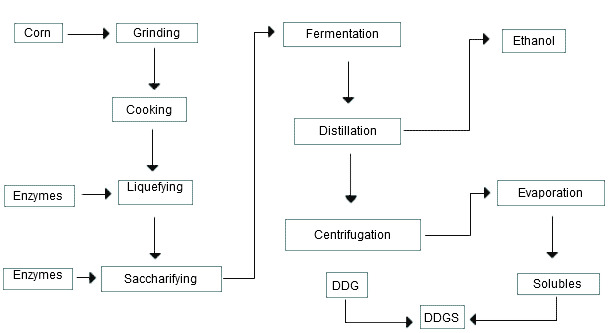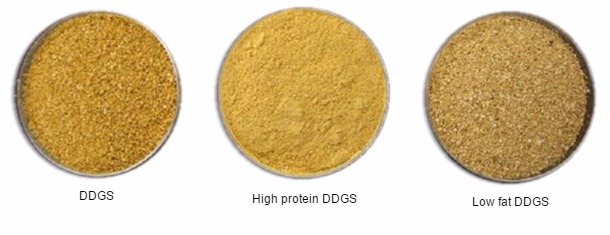The high cost of the ingredients used in the formulation of diets for pigs requires nutritionists to constantly look for alternative feeds that do not affect the animals performance. Thus, Distillers Dried Grains with Solubles (DDGS) are presented as an alternative because of their high energy and phosphorus contents (Table 1.)
Table 1. Nutritional composition of DDGS, barley and wheat —adapted from different authors.

| Nutrients | un. | Lescano, 2013 | NRC, 2012 | ||
| DDGS | corn | barley | wheat | ||
| Dry matter | % | 89.72 | 88.31 | 89.90 | 88.67 |
| Crude protein | % | 29.94 | 8.24 | 11.33 | 14.46 |
| Crude fibre | % | 7.87 | 1.98 | 3.90 | 2.57 |
| Ether extract | % | 8.34 | 3.48 | 2.11 | 1.82 |
| NDF | % | 33.92 | 9.11 | 18.29 | 10.60 |
| ADF | % | 13.94 | 2.88 | 5.78 | 3.55 |
| Total amino acids | |||||
| Lysine | % | 0.820 | 0.250 | 0.400 | 0.390 |
| Digestible lysine | % | 0.530 | 0.185 | 0.300 | 0.320 |
| Methionine | % | 0.610 | 0.180 | 0.200 | 0.220 |
| Digestible methionine | % | 0.510 | 0.149 | 0.164 | 0.194 |
| Threonine | % | 1.080 | 0.280 | 0.360 | 0.400 |
| Digestible threonine | % | 0.800 | 0.216 | 0.274 | 0.336 |
| Tryptophan | % | 0.210 | 0.060 | 0.130 | 0.170 |
| Digestible tryptophan | % | 0.150 | 0.048 | 0.107 | 0.150 |
| Valine | % | 1.490 | 0.380 | 0.520 | 0.580 |
| Digestible valine | % | 1.150 | 0.312 | 0.416 | 0.510 |
| Minerals | |||||
| Calcium | % | 0.18 | 0.02 | 0.06 | 0.06 |
| Total phosphorus | % | 0.84 | 0.26 | 0.35 | 0.39 |
| Phytic phosphorus | % | 0.26 | 0.21 | 0.22 | 0.22 |
| Apparent digestibility coefficient | % | 45.27 | 26.0 | 39.0 | 46.0 |
| True digestibility coefficient | % | 48.85 | 34.0 | 45.0 | 56.0 |
| Available phosphorus | % | 0.58 | 0.05 | 0.13 | 0.17 |
| Energy | |||||
| Gross energy | kcal/kg | 4943.25 | 3933 | 3939 | 3788 |
| Digestible energy | kcal/kg | 3647.25 | 3451 | 3150 | 3313 |
| Metabolizable energy | kcal/kg | 3507.75 | 3395 | 3073 | 3215 |
| Net energy | kcal/kg | 2339.00 | 2672 | 2327 | 2472 |
Two products are obtained in ethanol production: Dried Distillers grains (DDG) and the soluble portion, which can be added to the dried grains (DDGS) (Figure 1.) However, there are other types of DDGS that vary depending on the process used for their production, such as oil centrifugation and removal of solubles before adding them to the DDG, thus obtaining a product with a fat content of approximately 6 to 8% (NRC, 2012) (Figure 2.)

Figure 1. Adapted from MAIZAR (www.maizar.org.ar)

Figure 2. Adapted from www.alibaba.com
Depending on the ethanol production process and management of raw material (DDG and solubles), the final product shows variable features which are mainly influenced by the initial ingredient (variety, quality and type of grain, as well as environmental conditions), and the processing conditions (temperature, cooking time, distillation, dehydration and pelleting, etc.) (Blas et al., 2007.)
However, variability in nutrient content and digestibility of DDGS are a major challenge when formulating rations, especially in relation to lysine. The ethanol extraction process needs a high temperature, which can break down lysine into compounds that cannot be used in protein synthesis. This destruction is lower in DDG —unlike DDGS— because adding solubles increases the risk of Mayllard reactions, thereby decreasing lysine digestibility (NRC, 2012.) Because of this, Stein (2011) developed an equation to determine the standardized ileal digestibility of lysine in DDGS depending on the amount of lysine (Lys) and crude protein (CP):
Standardized ileal digestible lysine (%) = −0.6367 [0.858 × Lys (%)] × [0.12 × (100 × Lys (%) / CP (%))]
Due to the high concentration of vegetable fats, a negative correlation has been seen between the addition of DDGS and firmness of bacon and fat quality with levels above 30%. However, there is a positive relationship between saturated and unsaturated fatty acids, which are reasonable indicators of pork carcass fat quality (iodine values), higher values indicating softer bacon (A guide to Distillers Dried grains with solubles, 2012).
With regard to phosphorus, DDGS have a higher concentration than corn, because during fermentation process some of the phytate bonds are hydrolyzed, and yeasts produce small amounts of phytase. Similarly, concentration of Na, Ca and S is also higher due to the addition of sources of these minerals.

A major concern when using DDGS in pig feeding are the antibiotics used for ethanol production, since it is extremely difficult to control bacterial contamination during fermentation, especially by lactic acid bacteria, which compete with yeasts inhibiting their growth. Paulus-Compart (2012) conducted some research work in order to verify the presence of antibiotic residues in DDGS, and whether they were biologically active. The author concluded that, although virginiamycin was the most frequently used antibiotic in ethanol production, less than 1.3% of the DDGS samples analysed contained minimal residues of this antibiotic (0.5 to 0.6 mg / g), with virtually no inhibitory capacity, thus not posing a risk to human or animal health.
Scientific literature includes studies that evaluate the performance, digestibility and carcass characteristics of animals fed different levels of DDGS. However, results show great variability, linked to changes in DDGS nutrient composition, which is why we need to act with extreme caution when formulating diets for animals.
The NRC (2012) tables show recommendations for inclusion levels in diets for gestating sows (44%), post weaning piglets (20-30%), growing pigs (30%) and finishing pigs (30%), without affecting the animals performance. It should be noted, however, that these values —as those in any book or nutrition table— are only for reference, and may vary depending on environmental, nutritional and management conditions, as well as DDGS characteristics.
Due to their higher energy, phosphorus and amino acids content when compared to corn, wheat and barley, DDGS are presented as a nutritional and cheap alternative feed in the animals diet.




